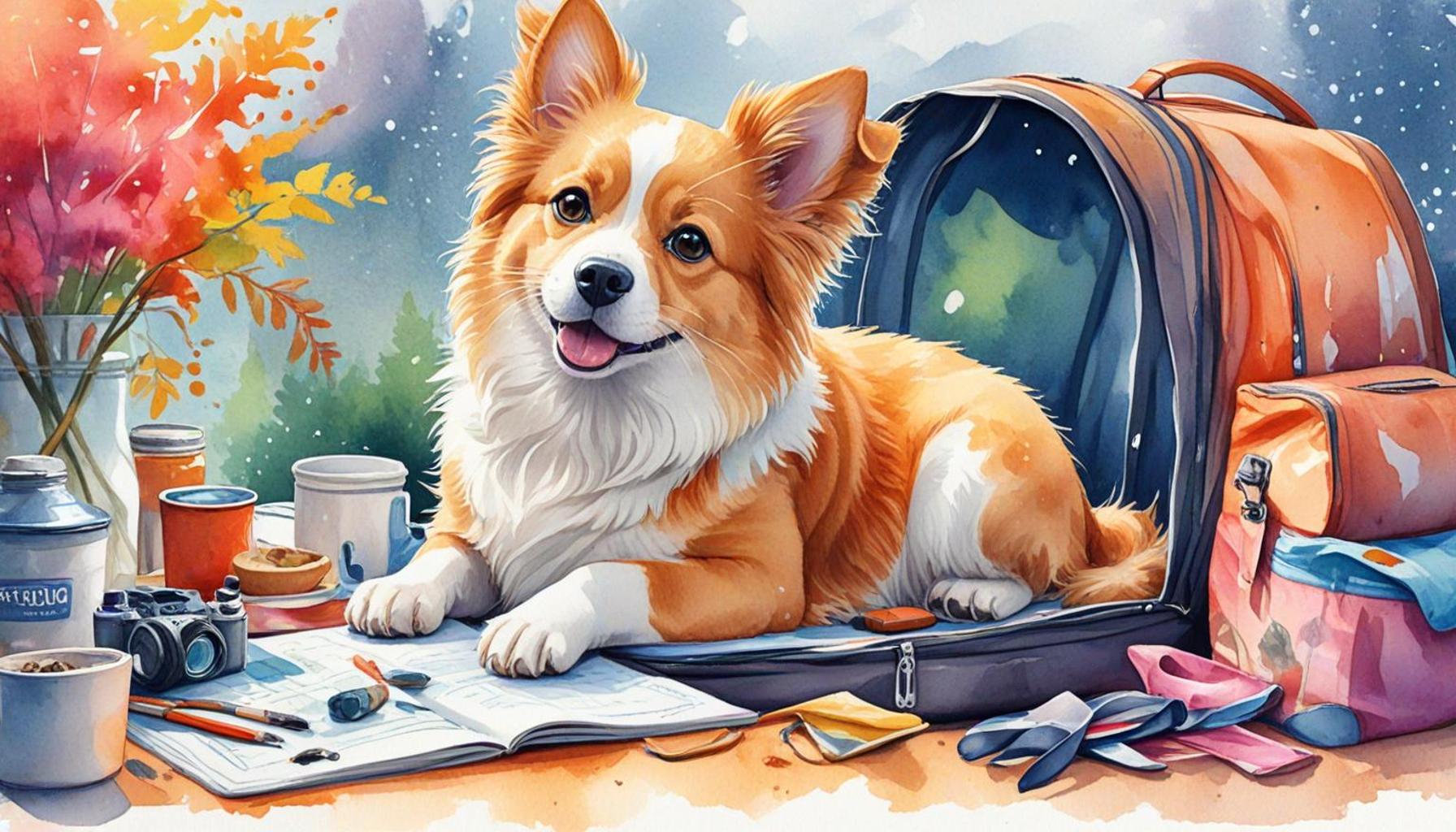Strategies for Dealing with Separation Anxiety in Pets

Understanding Separation Anxiety in Pets
Separation anxiety in pets is a prevalent issue that many pet owners experience globally, but it can be especially poignant in Nigeria due to unique cultural factors. When left alone, dogs and cats can exhibit a range of distressing behaviors. These behaviors may include excessive barking, destructive chewing, or inappropriate elimination. Understanding and addressing these behaviors is crucial for both the pet’s well-being and the owner’s peace of mind.
Identifying the Signs of Separation Anxiety
Recognizing the signs of separation anxiety is the first step towards helping an anxious pet. Look out for common behaviors such as:
- Whining, which indicates distress or a desire for attention.
- Pacing throughout the house, often in a repetitive pattern.
- Attempting to escape, which may include digging, scratching, or chewing at doors or windows.
- Increased vocalization, affecting neighbors and the overall household environment.
The emotional toll on pets experiencing these symptoms can be profound, further emphasizing the need for timely intervention.
Common Triggers
Several factors can trigger or worsen separation anxiety. For instance, changes in routine, such as a new work schedule or the children returning to school, can leave pets feeling abandoned. Additionally, moving to a new home can disorient them, as pets thrive on familiar scents and surroundings. Even the loss of a family member or companion animal can provoke heightened anxiety, creating feelings of isolation.
Impact on Pets
If untreated, separation anxiety can lead to serious consequences for pets, including depression and various health issues, ranging from stress-related illnesses to chronic behavioral problems. A stressed animal may reallocate its anxiety into physical manifestations, such as gastrointestinal issues or excessive grooming.
Cultural Considerations in Nigeria
In Nigeria, where family structures may be diverse and pet ownership is gaining popularity, understanding how to manage separation anxiety becomes even more essential. Cultural factors, such as community living and the presence of varied household dynamics, can influence how pets adapt to changes. For instance, a household with multiple caregivers may ease some pets’ anxieties due to increased social interaction, while others may struggle if not consistently attended.
Effective Strategies to Alleviate Anxiety
Fortunately, there are practical strategies pet owners can implement to help their furry friends cope with feelings of distress. For instance, gradual desensitization involves slowly increasing the duration of time your pet is left alone to help them adjust without triggering anxiety.
Providing engaging toys, such as puzzle feeders or chewables designed to occupy their attention, can also keep pets distracted during solitary times. Establishing a comforting routine that includes playtime, feeding, and cuddles can further instill a sense of security.
As we delve deeper into the upcoming sections, you will discover more effective techniques and methods to support your pet’s emotional health. Understanding separation anxiety not only fosters a nurturing environment for your pet but also strengthens the bond between you and your furry companion, giving them the sense of security they crave.
LEARN MORE: This related article may interest you
Effective Strategies to Alleviate Anxiety
Fortunately, there are various practical strategies pet owners can implement to help their furry friends cope with feelings of distress. Engaging in these strategies not only promotes mental well-being for pets but also fosters a harmonious home environment.
Gradual Desensitization
A highly effective method for addressing separation anxiety is gradual desensitization. This approach involves slowly acclimatizing your pet to being alone for short periods that gradually increase over time. Start by leaving your pet in a safe space for just a few minutes while you step out of the house. Gradually extend this time as your pet becomes more comfortable. Over weeks, this strategy can help reshape your pet’s response to being left alone, instilling a sense of security and confidence.
Engaging Toys and Distractions
Another important tactic is providing engaging toys. Interactive toys, such as puzzle feeders that require your dog or cat to think and work to access treats, can keep their minds occupied. Chew toys are also beneficial, allowing pets to expend energy constructively. This form of mental stimulation is especially vital in a bustling Nigerian household where distractions may be plentiful, keeping anxiety at bay.
Establishing a Comforting Routine
Creating a comforting routine can significantly reduce anxiety. Pets thrive on structure, so setting regular times for feeding, walks, and play can help them feel more secure. Consistent daily schedules offer predictability, which is crucial for pets prone to anxiety. For instance, if your pet knows they will have playtime in the morning and evening, this can create anticipation, ultimately easing feelings of loneliness when you’re away.
Socialization and Companionship
Integrating socialization into your pet’s routine can also be highly beneficial. Dogs, in particular, are social animals and often benefit from interaction with other pets. If you don’t have the time to spend with your dog throughout the day, consider arranging playdates with friends who have compatible pets. This social environment can mimic the companionship pets naturally seek, helping to alleviate feelings of isolation.
Positive Reinforcement Techniques
Utilizing positive reinforcement techniques is essential in alleviating separation anxiety. Reward your pet for calm behavior when you prepare to leave and return home. This can include giving them a treat or praising them for being relaxed. Over time, this teaches your pet that your departures and arrivals are non-threatening, significantly reducing their anxiety about your absence.
As we continue exploring effective techniques and methods to support your pet’s emotional health, remember that patience and understanding play critical roles in helping them overcome separation anxiety. By implementing these strategies, you’re not only enhancing your pet’s quality of life but also cultivating a deeper bond that fosters trust and security.
| Strategy | Description |
|---|---|
| Desensitization Training | Gradually expose your pet to being alone for short periods, slowly increasing the time to build their confidence. |
| Provide Engaging Toys | Offer toys that stimulate your pet’s mind, such as puzzles, to keep them occupied during absences. |
| Create a Safe Space | Set up a cozy, secure area where your pet feels safe using familiar items, reducing anxiety. |
| Routine Establishment | Maintain a consistent daily schedule for feeding, walking, and playtime to provide structure and security. |
Understanding your pet’s anxiety is crucial in finding effective solutions. By implementing these strategies, you can significantly alleviate symptoms of separation anxiety and foster a more balanced emotional state for your furry companion. Each principle not only enhances the pet’s comfort but also enriches their overall well-being, ensuring they live a satisfied and fulfilling life while you’re away. Engaging in these practices builds a stronger bond between you and your pet, creating an environment conducive to trust and happiness. As you explore these tactics, remember that patience is key—each pet is an individual and may respond differently. Adjust your approach based on their unique needs and responses.
RECOMMENDED: Check out this similar article
Additional Techniques for Easing Your Pet’s Worries
In addition to the approaches already mentioned, there are further strategies that can aid in effectively managing separation anxiety in pets. Utilizing these techniques creates an atmosphere in which pets can feel relaxed and secure, reducing their overall stress levels.
Comfort Items and Scent Therapy
Providing comfort items can work wonders for a pet experiencing anxiety. Familiar scents can have a calming effect. Consider leaving behind a piece of your clothing or a blanket that carries your scent when you have to leave. Pets often find solace in familiar items, as these can create a sense of security and belonging in your absence. Additionally, incorporating scent therapy with appealing odors such as lavender or chamomile can help create a more tranquil environment for your pet. However, ensure that any scents used are pet-safe and free from harmful chemicals.
Alternative Therapies
Exploring alternative therapies can also prove beneficial for pets struggling with separation anxiety. Techniques such as dog massage or employing calming music tailored for pets can provide soothing options. There are also supplements available that contain natural ingredients known to reduce anxiety, such as L-theanine or valerian root. If considering these options, it is crucial to consult with a veterinarian to ensure their safety and proper use tailored to your pet’s specific needs.
Professional Guidance
Sometimes, the challenges associated with separation anxiety in pets may require professional assistance. Engaging a qualified dog trainer or a certified animal behaviorist can yield beneficial results. These experts can offer personalized training plans and interventions that align with your pet’s unique situation. They can also guide you through behavioral modification techniques and help you better understand your pet’s anxiety triggers, equipping you with the tools needed for effective management.
Paw-sitive Group Play
Another innovative approach is joining a local pet daycare or group play sessions. These venues allow pets to interact with others while providing a social outlet that can diminish loneliness and fear when left alone. Many facilities in Nigeria cater specifically to dogs and cats, making it easy to find one nearby. Engaging in structured play can promote physical activity and mental stimulation, both of which contribute to reducing anxiety levels.
Maintaining a Calm Demeanor
Your own attitudes and feelings significantly influence your pet’s behavior. It is crucial to maintain a calm demeanor when leaving or returning home. Pets are adept at reading human emotions, and if you approach departures with hesitance or sadness, your pet may mirror this anxiety. It is advisable to keep goodbyes brief and upbeat. Upon returning, remain calm and avoid overwhelming your pet with excitement. This balance can help reassure your pet that their time alone isn’t something to dread.
Through the integration of these multi-faceted strategies, pet owners can create a nurturing environment that addresses their furry friends’ emotional health. By observing your pet’s behavioral patterns and experimenting with these techniques, you will likely move closer to finding the right set of solutions tailored for their anxiety. Embracing these methods ultimately leads to a happier life for both pet and owner.
SEE ALSO: Click here to read another article
Conclusion: Fostering Security and Comfort for Your Pets
In conclusion, separation anxiety in pets is a common yet addressable issue that can significantly affect the well-being of your furry companions. By implementing a combination of approaches such as providing comfort items, exploring alternative therapies, seeking professional help, encouraging social interactions, and maintaining a calm demeanor, pet owners can create a supportive environment that eases their pets’ distress.
It is essential to recognize that every pet is unique, with individual needs and triggers. Therefore, careful observation and consistent experimentation with various techniques are crucial in determining the most effective strategies. Utilizing methods like comfort items and tranquil scents can invoke feelings of safety for your pets, while alternative therapies, including massage or calming music, can further promote relaxation. For those facing significant challenges, collaborating with a qualified trainer can provide customized solutions that lead to long-term improvements.
Engaging with local pet daycares or group play sessions can also offer invaluable social opportunities, which are especially beneficial in a bustling country like Nigeria, where interaction among pets can mitigate feelings of loneliness. Ultimately, the connection between pet and owner is paramount; your attitude plays a pivotal role in shaping your pet’s emotional landscape. By implementing these strategies, not only will you nurture your pet’s mental health, but you’ll also cultivate a harmonious and joyful relationship, fostering a happier, more fulfilled life for both of you.


